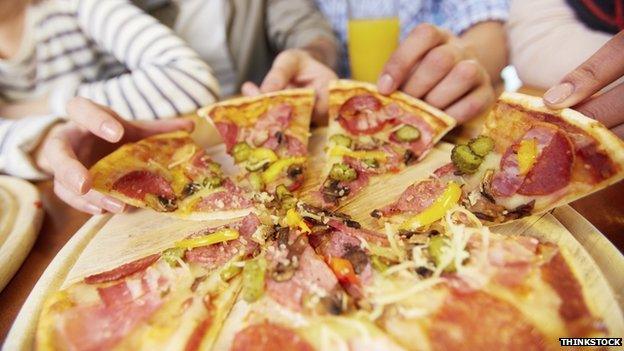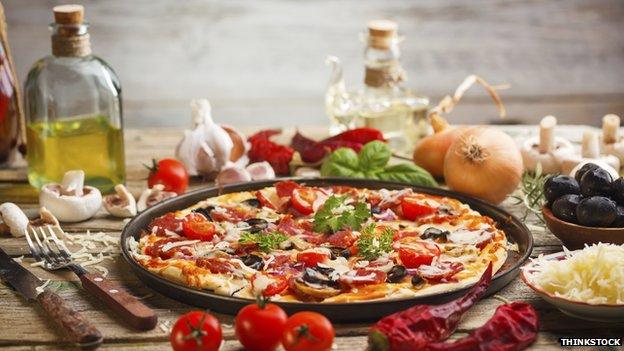The people who eat pizza every day
- Published

In any given day, more than 40 million Americans will eat pizza. It is considered the most popular meal in the world, and definitely one of the favourites in the US.
The love for this food is such that the Department of Agriculture recently released a report on the levels of consumption. It described the meal as "a contributor of nutrients of public significance in the American diet, including total fat, calcium and sodium."
However, just because it's popular, does that mean it's bad for you?
Experts would argue that pizza as such is not bad for your health - the problem is when and how you eat it.

According to the report, 13% of the USA population consume pizza on any given day increasing to 22% when children and teenagers are included.
This wouldn't be of such concern if it was mainly a homemade dish.
Giuseppe Russolillo, president of the Spanish Association of Nutritionists, said: "You have to bear in mind that while in the majority of Italy this is an artisanal product, in the US it is more related to 'junk food'."
Most of the time it is bought from a fast food chain or frozen at a supermarket, he says.
In the US men eat more pizza than women, but habits vary between ethnic groups.
The non-Hispanic whites are the ones that eat most pizza (around 16% of them). While about 14% of both black non-Hispanics and Hispanics eat at least one slice on any given day.
Ruben Bravo, of the European Medical Institute of Obesity, told BBC Mundo: "This tells us about the diet in the US, and that this could well be one of the reasons why this country has the highest numbers of obesity cases."
Russolillo agrees with Bravo. He adds that pizza shouldn't be consumed more than two or three times a month.
"And it shouldn't be part of the daily diet, even less for children," he adds, "Because it is during that period of growing development that you have to provide a varied and healthy diet with lots of vegetables and fruit."
'Pizza abuse'

The pizza was introduced in the US at the beginning of the 20th Century, due to the influence of Italian immigration.
The first restaurant opened in New York in 1905. And since then, the love for this food has grown to estimated sales of three billion pizzas each year.
According to the report, pizza contributes to 6% of the total energy intake for children (two to 19 years old) and 4% for adults.
On the day consumed, pizza represents 27% of total energy among all consumers.
"The mean energy intake obtained from pizza was 538 kilocalories for children and 744 kilocalories for adults," says the report.
"The problem is not the pizza, it's pizza abuse. It is a highly calorific food," says Ruben Bravo.
"But it is the same with a sandwich. We are talking about refined flours with fat that aren't good for health."
What about nutrients?

Pizza is a great source of nutrients in the American diet. It provides high percentages of the total daily intake of protein, fat, saturated fat, fibre, calcium and lycopene.
According to the report, this food represents a third of the total daily intake of calcium and more than half of lycopene, a micronutrient and very effective antioxidant.
Also, this meal is a source of sodium for both children and adults.
However, Bravo explains that even though you can make healthy pizza at home, most of the time we are talking about a pizza factory product, high in carbohydrates and saturated fat.
"It has refined flour, no wholemeal, and we now know that an excess of this ingredient contributes to obesity, increases cholesterol and, with time, has a tendency to raise the sugar levels in the blood."
Nevertheless, Bravo concedes that, as a cereal, pizza provides nutrients and micronutrients that are also valid.
"If we are talking about homemade pizza, then it could be included in our diet once a week," says Russolillo.
He says that that doesn't mean that we have to promote this product, "when there are plenty that are more important, like vegetables".
Star dish of the night

Perhaps what worries the specialists the most is not what people eat, but how they eat it.
If it is made at home, without all the preservatives and industrialised ingredients high in fat and salt, the pizza can be a good source of nutrients as long as it is not eaten at night.
However, 44% of children and 59% of adults that eat pizza in the US do it at dinnertime.
"The latest research on body biorythm and circadian rhythm suggests that eating food high in carbs and saturated fat at night leads to an increase in body fat," explains Bravo.
This means that in the long term these nutrients could be contributing to obesity.
"Also, a heavy meal for dinner (such as pizza) could be the cause of a sluggish digestion and sleep problems," Dr Bravo adds.
Therefore, it is not the same having pizza at lunchtime, and having pizza at night.
But, how can you make the best of the fact that millions of Americans eat pizza?
"Firstly, do not eat it at night", answers Bravo. "Secondly, use ingredients low in fat." And make it yourself.
Russolillo adds that the message should be: "If you want to eat pizza, do it with caution and moderation."